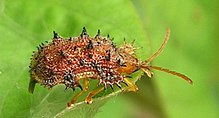Cassidinae: Difference between revisions
m Bot: Migrating interwiki links, now provided by Wikidata on d:q1309564 |
m Bot: Migrating interwiki links, now provided by Wikidata on d:q2120908 |
||
| Line 60: | Line 60: | ||
{{Chrysomelidae-stub}} |
{{Chrysomelidae-stub}} |
||
[[cs:Cassidinae]] |
|||
[[de:Schildkäfer]] |
|||
[[fr:Casside]] |
|||
[[ka:ფაროსნები]] |
|||
[[ja:カメノコハムシ亜科]] |
|||
[[no:Skjoldbiller]] |
[[no:Skjoldbiller]] |
||
[[ru:Щитоноски]] |
|||
[[tl:Cassidinae]] |
|||
Revision as of 18:35, 26 August 2013
| Cassidinae | |
|---|---|

| |
| Platypria sp. | |
| Scientific classification | |
| Kingdom: | |
| Phylum: | |
| Class: | |
| Order: | |
| Suborder: | |
| Superfamily: | |
| Family: | |
| Subfamily: | Hispinae Gyllenhal, 1813
|
| Tribes | |
| |
The Cassidinae (tortoise and leaf-mining beetles) are, in a broad sense, a subfamily of the leaf beetles, or Chrysomelidae. It includes both the traditional Hispinae (leaf-mining beetles), as well as the former more narrowly defined subfamily Cassidinae (familiar as tortoise beetles) which are now split into several tribes that include the tribe Cassidini, and in all include over 125 genera. The traditional separation of the two groups was based essentially on the habitats of the larvae and the general shapes of the adults. The name Cassidinae for the merged subfamily is considered to have priority.[1]

Most members of the tribe Hispini are elongated beetles with parallel margins, with antennae bases close together on their small heads. They often have punctate elytra and pronotum, sometimes with spines both on and along the edges. The former grouping of Cassidinae (sometimes called tortoise beetles) included the tribes Aspidimorphini, Basiprionotini, Cassidini, Delocranini, Dorynotini, Eugenysini, Goniocheniini, Hemisphaerotini, Imatidiini, Ischyrosonychini, Mesomphaliini, Notosacanthini, Omocerini and the Spilophorini. The "cassidines" have a rounded outline with the edges of the pronotum and elytra spreading out to cover the legs and head. Cassidines are often colourful and metallic, with the ability to change the colour (and lost in specimens) which is present in the living tissue below the translucent cuticle. The subfamily has the mouthparts reduced into a cavity in the head capsule, the legs have four segmented tarsi. Although these shields are thought to provide defense, no evidence exists for such a role.[2] The Hispini have larvae that are leaf miners, while the "cassidines" feed on the plant surfaces, sometimes covering their bodies with faecal shields. Some Cassidini show maternal care of larvae.[3]
The subfamily names Cassidinae and Hispinae are both founded by Gyllenhal in the same 1813 book, but the name Cassidinae occurs on an earlier page and therefore is considered to have priority, which can only change on application of the Principle of the First Reviser, Chen in this case,[4] who also gave priority to the name Cassidinae.[1]
References
- ^ a b Chaboo, CS (2007.). "Biology and phylogeny of the Cassidinae Gyllenhal sensu lato (tortoise and leaf-mining beetles) (Coleoptera: Chrysomelidae)". Bulletin of the American Museum of Natural History. 305: 1–250. doi:10.1206/0003-0090(2007)305[1:BAPOTC]2.0.CO;2.
{{cite journal}}: Check date values in:|year=(help)CS1 maint: year (link) - ^ Bottcher, A;Jorge Paulo Zolin; Flávia Nogueira-de-Sá; José Roberto Trigo (2009). "Faecal shield chemical defence is not important in larvae of the tortoise beetle Chelymorpha reimoseri (Chrysomelidae: Cassidinae: Stolaini)". Chemoecology. 19 (1): 63–66.
{{cite journal}}: CS1 maint: multiple names: authors list (link) - ^ Flowers, RW. "Leaf beetles (Coleoptera: Chrysomelidae)". In Capinera, JL (ed.). Encylopedia of Entomology (2 ed.). Springer. p. 2148.
- ^ Chen, S. H. (1940). "Attempt at a new classification of the leaf beetles". Sinensia. 11: 451–481.
